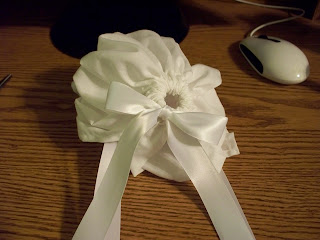How did everyone do last week with their smocking? Great I hope! This week's lesson is how to do Bullions and Lazy Daisy stitches. So let's get started. Make sure you have removed the pleater threads before starting the embroidery. If you didn't use a milliner needle on the smocking, you need to use one now. I've tried using other needles and it just is too frustrating. Learn from my mistake.
1. I have to apoligize this pic isn't the greatest. Anyway, the center 2 pleats is where we want to start the first bullion. I've brought my darker pink thread up to the side of the center 2 pleats , then went through those 2 pleats. Do not pull your floss through the pleats just yet.
2. Next you are going to wrap the floss clockwise 6 times around the needle. Keep the wraps firm, but not too tight else you won't be able to pull your needle through the wraps. I hold the wraps firmly with thrumb and forefinger and then pull the needle with the other hand. If the needle does not pull through easily, just loosen up your wraps a little. It should now slide through with no problem.
3. When you get the floss pulled all the way through, poke the needle to the back side and knot off. Make 2 more rosebud centers. One to the left and one to the right. See next pic for placement.
4. Thread needle with lighter pink floss for the outer petals of the rosebud. Notice we are going to go through 4 pleats for the outer petals.
5. Wrap needle 10 times clockwise and pull the needle through. After finishing a bullion, you may need to gently move some of the wraps. Sometimes your bullion can look a little lopsided.
6. Form the second petal by going back through the pleats just before, doing 10 wraps. Knot off after finishing each rosebud.
7. For the leaves, switch to green floss. As you can see from the pic you bring your need up through the bottom of the rosebud then go through a few pleats. Do not pull the needle yet. Wrap the thread under the top of the needle.
8. As you can see, I've pulled my floss tight to the needle. Now pull the needle through and the floss straight up. Only pull until the floss is flush with the pleats. Not too tight or you risk distorting your newly formed leaf.
9. At the top of the lazy daisy stitch just made, secure the stitch by poking the needle on the top of the loop and pull thread through to the back of the pleats.
10. Stitch 2 leaves per rosebud. Next rinse out any blue marks left from the pleating process. Let air dry.
11. Next for the ties. I cut approximately 18" for my ties. Use fraycheck or whatever fray blocking product you like on all the cut edges of ribbon. Fold one end up about 1" and then again.
12. Using and all purpose sewing thread, weave the needle through the 3 layers of ribbon.
14. Pull firmly and then wrap the thread around the center and then take a little stitch in the side of the ribbon to secure.
15. I've attached the ribbon to my bonnet and added a premade bow to the top of the ribbon.
16. Thread a piece of ribbon measuring about 24" long using a bodkin through the casing at the back of the bonnet. Tie a pretty bow.
17. Ta-da! You've created a very sweet bonnet for an equally sweet baby. For my class I'm teaching, I've done the smocking in red and will add red ribbon roses to the sides. If you want to send me a pic of your finished bonnet, I will post it on my blog and brag about what a great job you've done. Give yourself a pat on the back for learning something new. Here's my email:
jmboyd@clear.netHappy smocking everyone!






























